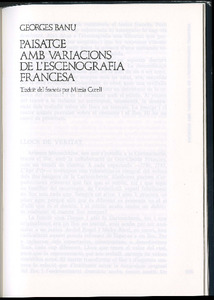Paisatge amb variacions de l'escenografia francesa

Ver/descargar
Metadatos
Mostrar el registro completo del ítem
Estudis escènics: quaderns de l'Institut del Teatre. 1985, Núm. 27
Tipo de documentoArtículo
Resumen
<p>The distrust of the theatre in the Italian manner has been followed by its revaluation; this coincides with a revival of the interest in image and distance to the detriment of the search for contact and intimacy with the audience. However, the return to the theatre in the Italian manner does not correspond with the disappearance of works about non-theatrical spaces. <em>Image </em>and <em>theatre </em>only prevail over <em>contact </em>and <em>place. </em>Priorities have changed. The experiences of Arianne Mnouchkine at the Cartoucherie, and those of André Engel and Nicky Rieti, who look for new spaces for each performance, reveal this trend. Other directors, such as Roger Planchan and Jean-Pierre Vincent, have addressed painters of the «new figuration» for their scenographies. Patrice Chéreau and Richard Peduzzi have prefered the «utopian architectures » recreating places that upset for their ambiguity although they seem familiar. For Peter Brook, on the contrary, architecture becomes scenography. Antaine Vitez and Yannis Kokkos reconstruct the «state of theatre» as it were a «state of mind». In the French scenography there is a confrontation between these two ways: the <em>true </em>and the <em>false. </em>The return to the use of the curtain is symptomatic of the return to the image of theatre created by the passing of time: a theatre of imagination and secrecy, a theatre of distance and nota theatre of proximity.</p>
Condiciones de accesoAcceso abierto
ISSN2385-362X
,
0212-3819
Colecciones
- 1985: Núm.: 27 [7]

